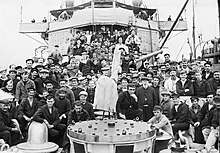HMHS Britannic

The HMHS Britannic was a British ocean liner. The ship was also used as a war ship and a Royal Mail steamer. The Britannic was finished on 26 February 1914, for the White Star Line.[1] It was a sister ship to the Olympic and the RMS Titanic. The building of the ship was held up when the Titanic sunk, and extra safety items were added to the Britannic.[1]
World War I, Last Voyage[change | change source]
The start of World War I meant the ship was not used for passenger work. It was set up as a hospital ship with 3,300 beds. She sailed to Mudros on the 23 December 1915, to pick up wounded soldiers from Gallipoli.[1] She continued as a hospital ship until 1916 when it was turned back into a Royal Mail and passenger ship. Before this latest change was carried out, the ship was called back into war service and went back to Mudros.
There were 1,066 people on board: 673 crew, 315 Royal Army Medical Corps (RAMC), 77 nurses, and the captain. Britannic was under the command of Captain Bartlett.
Sinking of the Britannic[change | change source]

On 21 November 1916 the Britannic was rocked by an explosion, after hitting a naval mine in the Kea Channel, off the Greek island of Kea. The mines had been put there by the German submarine U-73.[1] A huge explosion tore a hole in the side of the ship which sunk one hour later. The ship was carrying 1,125 people, and nearly all were saved. Two lifeboats were struck by the ship's propellers and 30 people were killed.[1] Bartlett finally stopped the propellers before they could suck in any more lifeboats. Bartlett re-engages Britannic’s engines one last time in one final attempt to the island of Kea, pausing the evacuation. At 9 A.M., he ordered the Britannic’s propellers to stop for one final time, and ordered and told everyone it was time leave and evacuate. The lifeboats were launched from the ship. Her final plunge began with her stern beginning to rise from the water, exposing the propellers. Then, as Britannic began to slowly dip beneath the surface, survivors from the Britannic said they heard what sound is like a tremendous roar or bang coming from the front section of the ship that was already submerged.
What this was was the ship’s bow slamming into the sea floor. Britannic was over 800 feet long, and it only sank roughly 400 feet of water, so the bow hits the sea floor before the stern was completely submerged. Once this occurred, it caused massive structural damage to the Britannic’s hull and we can see the evidence of this in the wreck today there’s a massive hole in the bow section. Then, at roughly 9:07 AM, Britannic’s stern slowly dipped beneath the surface, 55 minutes after the explosion by a naval mine. The German newspapers claimed that the ship had been sunk by a torpedo because it might have been carrying soldiers. The captain of the U-73 said this was not true, he had only been laying the naval mines. The survivors believe the Britannic was torpedoed.
